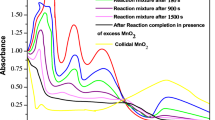Abstract.
It is well known that the antioxidant activity of some species in homogenous solutions may not be the same as that in heterogeneous media. This environment dependence is the reason for investigating ascorbic acid antioxidant activity in surfactant solutions. In our study we have investigated the kinetics of atmospheric oxidation and electrochemical oxidation of ascorbic acid in aqueous solutions of the four surfactants: SDS, AOT (anionic), TRITON-100 (nonionic), and CTAB (cationic). For each surfactant the concentrations below and above CMC were investigated. As expected, a general trend in the atmospheric oxidation rate changes in the following manner: the micellar solution of nonionic surfactant shows a faster oxidation rate than that of the anionic surfactant, and the cationic surfactant an even higher one. The more subtle effects were observed with each surfactant concentration change. The influence of the surfactants on the electrochemical behavior of ascorbic acid was also studied. A general conclusion emerging from our investigation is that surfactants shift the ascorbic acid oxidation potential and change the peak current value. This phenomenon is due mainly to the surfactant film formed at the electrode/solution interface.








Similar content being viewed by others
References
Davies MB, Austin J, Partridge DA (1991) Vitamin C: Its chemistry and biochemistry. The Royal Society of Chemistry Paperbacks, Thomas Graham House, Science Park, Cambridge
Manzanares MI, Solís V, de Rossi RH (1991) J Electroanal Chem 407:141
Friedrich W (1988) Vitamins. WdeG, de Gruyter
Ormonde DE, O'Neill RD (1990) J Electroanal Chem 279:109
Wen XL, Han ZX, Rieker A, Liu ZL (1997) J Chem Research (S):108
Wen XL, Jia YH, Liu ZL (1999) Talanta 50:1027
Szymula M, Szczypa J, Friberg SE (2002) J Dispersion Sci Technol 23 (6):1
Hiemenz PC, Rajagopalan R (1997) Principles of colloid and surface chemistry, 3rd edn. Marcel Dekker, New York
Zheng L, Li F, Hao J, Li G (1995) Colloids Surf A: Physicochem Eng Aspects 98:11
Paredes S, Tribout M, Ferreira J, Leonis J (1976) Colloid Polym Sci 254:637
Szymula M (1990) Ph.D. Thesis UMCS Lublin Poland
Linke WF (1965) Solubilities of inorganic and metal-organic compounds: A compilation of solubility data from the periodical literature, 4th edn. American Chemical Society, Washington, D.C.
Han YK, Oh SG, Shin SI, Joung WD, Yi SC, Cho CG (2002) Colloid Surf B: Biointerfaces 24:33
Abraham MH, Chadha HS, Dixon JP, Rafos C, Treiner C (1995) J Chem Soc Perkin Trans 2:887
Chaimovich H, Cuccovia IM (1997) Colloid Polym Sci 103:67
Bunton CA, Gillitt ND, Mhala MM, Moffatt JR, Yatsimirsky AK (2000) Langmuir 16:8595
Stilbs P (1983) J Colloid Interface Sci 94 (2):463
Shah SS, Saeed A, Sharif QM (1999) Colloids Surf 155:405
Hu IF, Kuwana T (1986) Anal Chem 58:3235
Karabinas P, Jannakoudakis D (1984) J Electroanal Chem 160:59
Casella IG, Electroanalysis (1996) 8(2): 128
Ruiz JJ, Rodrigez-Mellado JM, Dominguez M, Aldaz A (1989) J Chem Soc Faraday Trans 1 85(7):1567
Saba J (1995) Collect Czech Chem Commun 60:1457
Saba J (1996) Electrochimica Acta 41(2):297
Downard AJ, Roddick AD (1994) Electroanalysis (1995) 7(4):376
Sykut K, Dalmata G, Nowicka B, Saba J (1978) J Electroanal Chem 90:299
Korolczuk M (2000) Talanta 53:679
Davidovic A, Tabakovic I, Davidovic D, Duic LJ (1990) Electroanal Chem 280:371
Galus Z (1979) Elektrochemiczne Metody Wyznaczania Stałych Elektrochemicznych. PWN, Warszawa (in Polish)
Wen XL, Zhang J, Liu ZL, Han ZX, Rieker A (1998) J Chem Soc Perkin Trans 2:905
Kiraly Z, Findenegg GH (1998) J Phys Chem 102:1203
Acknowledgements.
We are very grateful to Professor J. Saba and Professor M. Korolczuk for valuable discussions and to Mgr. J. Szaran for his assistance with the measurements of differential capacity.
Author information
Authors and Affiliations
Corresponding author
Rights and permissions
About this article
Cite this article
Szymula, M., Narkiewicz-Michałek, J. Atmospheric and electrochemical oxidation of ascorbic acid in anionic, nonionic and cationic surfactant systems. Colloid Polym Sci 281, 1142–1148 (2003). https://doi.org/10.1007/s00396-003-0889-y
Received:
Accepted:
Published:
Issue Date:
DOI: https://doi.org/10.1007/s00396-003-0889-y




